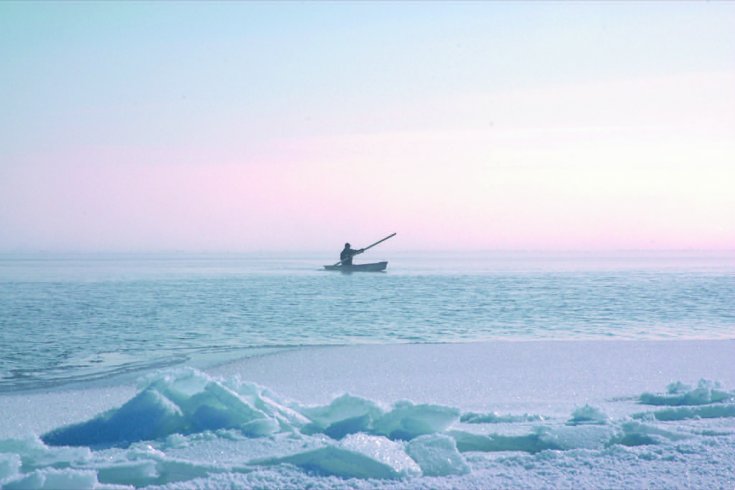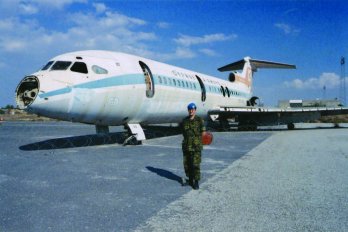
Igloolik—Ku-nuk, ku-nuk, ku-nuk. Waves of ice. This is the sensation of riding in a wooden sledge across the frozen Arctic sea. My head is bobbing like a dashboard doll. My brain is reeling with regret. Kun-uk, kun-uk, kun-uk. It’s not too cold (-20), but my feet, stuffed into sub-sub-zero boots, are nonetheless congealing against the wind-chilling pace of the snowmobile towing us. There are eight of us in this equipment sledge, a box on two skis, and I’m riding hard on the plywood floor. Ku-nuk, ku-nuk.
The day before, I was in the workroom of Zacharias Kunuk, the Inuit filmmaker whose film set I was visiting in Igloolik, a village of 1,300 souls in Nunavut. We had just finished an interview covering his life, his art, and his hopes for the future when he said, “Tomorrow is an off-day. I’m going to the floidj.” He rubbed his palms in anticipation.
I asked if this place, this floidj, held some spiritual significance for him. He looked at me pityingly. Floe edge. Where the ice pack meets the open water. “It’s where the seals are.”
“You’re going seal hunting?”
“Yeah. Want to come?”
My knowledge of seals is limited to the slick-furred torpedoes at the Toronto zoo—clever, cavorting creatures, the role model for mermaids. The idea of watching one being killed and butchered was not instantly appealing. Then again, it wasn’t an invitation one receives every day. Kunuk, whom his creative collaborator, Norman Cohn, describes as a “hunter who happens to make movies,” has an intimate relationship with Arctic fauna. His boots, his pants, his mittens—oh, to have those on the sledge— are an amalgam of the life-preserving qualities of many animals: sealskin and gut, caribou hide.
Kunuk and Cohn’s first feature film, Atanarjuat: The Fast Runner, was an art-house sensation in 2001, when it won the Camera d’Or, the debut-film prize of the Cannes festival, and went on to dazzle international audiences. A beautifully shot murder-romance suffused with elements of Inuit legend, the movie was the first Canadian feature to be written, produced, directed, and acted by Inuit. The follow-up, The Journals of Knud Rasmussen, which Kunuk and Cohn are working on here in Igloolik, looks at the near-extinction of Inuit culture through the eyes of elders speaking to Knud Rasmussen, an ethnologist from Greenland who travelled through this area in the 1920s.
Ku-nuk, ku-nuk. I’m cursing the sound, if not the name, when suddenly we stop. I peer over the plywood edge. A massive, million-faceted sapphire, thirty feet high. An iceberg, a sudden mountain in this plane of white. Kunuk hacks off chips into a bucket to melt for the coming stew. Engines roar back to life. Ku-nuk, ku-nuk.
More hypertrophied minutes. Cohn roars by on his own Ski-Doo, like a Battle of Britain pilot in a sheepskin jacket and flying helmet. Easy for him, with those marvellous suspension springs. My tailbone is raw from pounding the sledge’s floor, and my toes no longer believe in my existence. It’s time to say something. The nearest person is a smiling woman in full Michelin; her smile is all I can see. An envious gaze at her footwear: giant bulbs of foam within foam within Gore-Tex.
“I can’t feel my feet,” I say conversationally.
“We’re almost there,” says the smile. “We’ll give you the tummy treatment.”
Another stop. Kunuk is scanning the horizon to scout a safe route forward, picking a path around potentially treacherous spots. For good reason: we pass a cairn, tribute to a Caterpillar driver who fatally plunged through a patch of weak ice.
Finally, silence. The vista is pure azure. It’s not the top of the world by any stretch, but here, somewhere between Melville Peninsula and Baffin Island, I feel the pitiless vastness with a mixture of pride and terror. The line between ice and water is not absolute at the floe edge: there’s a mushy blue-grey margin. Step on it and you slither in; they’ll find you in the summer melt. I’m here. I have no toes, but I’m here. I try wiggling them. If they’re moving, there’s no indication.
I find the young woman, Catherine, from the sledge.
“Give me the tummy treatment.”
The tummy treatment, I readily admit to her, is better than sex. We sit opposite each other, like kindergarten playmates. She spreads her legs, the easier to accept my offered ones, pulls off my boots, and stuffs their frozen contents under her parka, onto the exquisite radiance of her abdomen. Such a sigh has never passed from my lips. Five minutes of gradually building ecstasy. I smile, I beam at my saviour. She lights a cigarette.
Jason, Kunuk’s nephew and one of the production’s technical wizards, comes by to offer “frozen sushi.” He snaps off a piece of Arctic char, which thaws in my mouth, then tastes sensational. There’s a bang and a commotion. Kunuk has already shot a seal. Jason hurries over to launch a flatboat to fetch the animal. “You’ve got to get it quick or it will sink,” says Catherine, who happens to be Kunuk’s niece and a film student at Carleton University in Ottawa.
The evisceration is shockingly simple. A large knife slices open the animal’s underside. Bare-handed, Jason opens the cavity and Kunuk reaches in to pull out the wire-thin intestine, which he loops in gory circles as though finishing up with the garden hose. He pulls out his own knife and relieves the carcass of its liver: packed with vitamin A, the organ was once key to survival in this extreme world. He slices off an end and savours it, then offers me a still-steaming morsel. It tastes, in another disturbing but homely revelation, like filet mignon.
The seal’s fur will make a pair of boots, the thick blubber will supply oil for lamps. The bones are popped into a pot of melted iceberg water to flavour a seaside stew. Freshly brewed coffee is burbling on the propane stove, but my feet are starting to go and I must heed them.
The return journey promises to be more comfortable, but Cohn, who has agreed to take me back early, can’t start his snowmobile. Jason gets under the hood and sets to work. One, two, three pulls and nothing; finally, on the seventh, a vroom. Jason looks at Cohn meaningfully: do not turn off the Ski-Doo.
Cohn mounts the machine and I climb on behind him. He takes a last look at Kunuk’s gps monitor; we are a dot far from the shoreline. Even in the worst-case scenario we probably won’t die but we will have to wait hours to be rescued.
The waves of ice are smoothed out by the snowmobile’s suspension. I see the cairn, then the iceberg, then, tiny in the distance, the huge fuel-storage tanks of Igloolik. Cohn stops the machine and climbs off, engine running.
“Still alive?”
I nod.
“Gotta take a leak.”
For one mad moment, like a man on the edge of a cliff feeling an irrational impulse to jump, I look at the kill switch on the machine. Cohn climbs back on and whisks me to the front door of my “hotel,” a complex of school portables. I roll off.
“We really mainlined you, didn’t we?”




